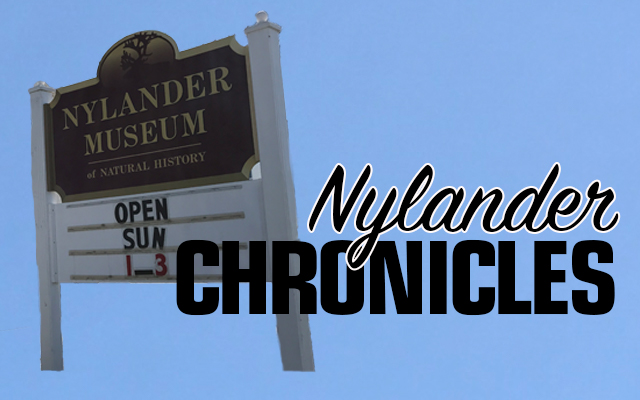Aroostook County hosts a wide variety of ferns, which are an important part of the local environment. While ferns are a beautiful addition to a garden landscape, they have been growing wild for over 300 million years, and are often found as fossils. Olof Nylander was an expert of his time on ferns, and even grew them on his farm in Woodland.
The following is an abridged selection of his notes on various species he found in Aroostook County.
Notes on Aroostook County Ferns
Ferns are among the most common plants of our forests, and are found under all conditions and in all kinds of places, from the mountain tops to the deepest valleys. Their graceful forms and dark green foliage make them very beautiful for planting in shady places, and I hope that our people will take to planting them more frequently in the parks and on private grounds, as they do in other states.
There is great variety in the distribution of the ferns in this state. The great abundance of the Polypodies and Christmas Ferns in Washington and Penobscot Counties and their rarity in Aroostook is notable. On the other hand the appearance of Aspidium Goldianum in New Sweden is surprising. It is probably the farthest north this has been recorded, and Polystichum Braunii in Woodland, Perham and New Sweden is probably farther north than recorded before in Maine.
Common Polypody — In the eastern part of Aroostook County I have collected this fern on the Mars Hill mountain, but it seems to be absent in the towns of Caribou, Woodland, Perham and New Sweden. I have several times planted it on my farm in Woodland, but the plants have not lasted more than two or three years.
Maidenhair fern — Adiantum pedatum L. Small patches of the Maidenhair Fern are found sparingly on the hills in New Sweden, Woodland and Caribou. They have a very vigorous growth. In New Sweden on the East Side of Capitol Hill I have collected plants two feet tall.
Common Brake — Pteris aquilina L. Common on newly cleared land, and sometimes in the woods.
Spleenwort — Asplenium acrostichoides Sw. Often found around large hardwood trees in the forest, where the leaf mould is deep and rich.
Lady Fern — Asplenium Filix-femina (L.) Bernh. The Lady fern is common in our forest, especially in mix woods. The fronds are very variable in form.
Christmas Fern — Polystichum acrostichoides (Michx.) Schott. This evergreen and noted fern is very rare. On Fogelius Hill, New Sweden, only five small, depauperated plants have been seen. It is not at home in our soil. I have never seen it in Caribou or Woodland. I have found one single plant in Perham. A large plant of this fern was observed in the woods near Crystal R.R. station in 1904, the largest I have seen. Annotations: Linnius Smyrna (?) very large plant.
Prickly Shield Fern — Polystichum Braunii (Spenner) Fee. This is the most interesting and beautiful fern in Aroostook. It is not common. I have collected several plants in New Sweden, Woodland and Perham. It is found in deep rich soil in the hardwood forest.
Shield Ferns — Aspidium fragrans (L.) Sw. Locally found on the hills and near the Aroostook River. Aspidium marginale (L.) Sw. Common in the forest. The rich green foliage is an object that every one notices in the autumn. It is evergreen.
Aspidium Goldianum Hook — This large and rare fern I found on the east side of Capitol Hill, New Sweden. When I first discovered Goldie’s Fern in 1904 there was a patch of about two acres of it in the deep forest, containing over two thousand plants. I have taken a number of plants of this very rare fern and transplanted them onto my farm in Woodland, and they are doing finely. This is the only place where I have seen this fern growing.
This column is the work of members of the Nylander Museum’s Board of Trustees.








